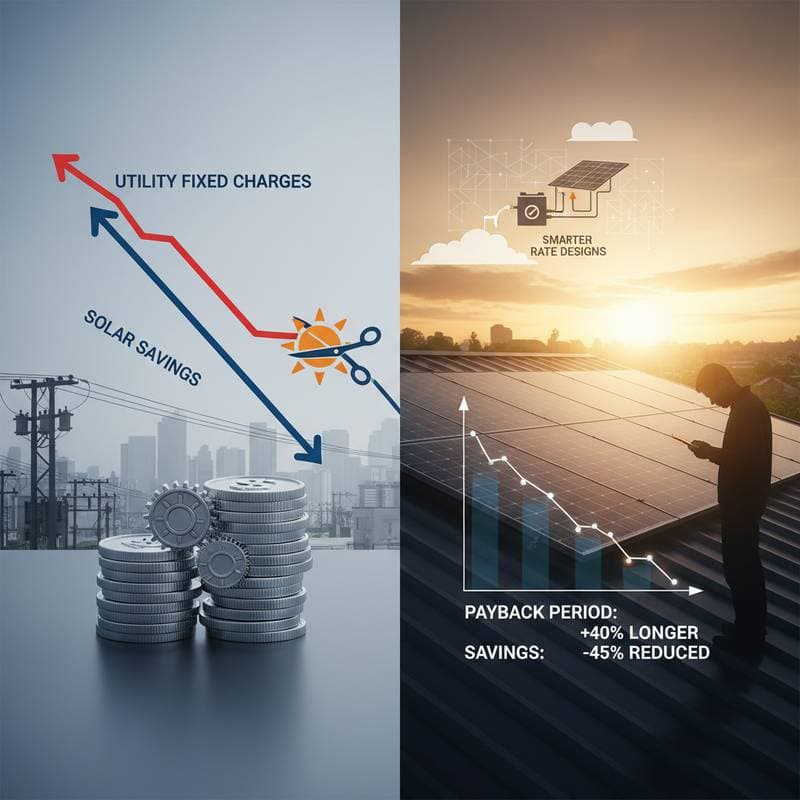Utility Fixed Fees Surge 40%: A Growing Threat to Solar Savings
Recent filings with state public utility commissions reveal that fixed charges for utility customers in several U.S. states have increased by an average of 40 percent. These charges, which customers pay irrespective of their energy usage, are altering the financial landscape for residential and small commercial solar installations. Experts predict that such rate changes will prolong solar system payback periods by multiple years, diminishing the drive toward decentralized energy production.
Understanding Fixed Charges and Their Impact on Solar Returns
Fixed charges appear on monthly bills as customer or service fees and serve to fund utilities' grid upkeep and operational expenses. For solar users, these fees limit the share of the bill that self-produced power can offset. Consider a typical homeowner with a 7-kilowatt rooftop array: under prior rates, they might offset 60 to 70 percent of electricity expenses. With elevated fixed charges, that offset could fall to approximately 40 percent.
Laura Chen, a senior policy analyst at Grid Strategies in Washington, observes, "These rate adjustments fundamentally alter the appeal of solar ownership. As fixed costs climb, customers gain less influence over their total bills, despite committing to sustainable energy solutions."
Solar adopters must now weigh these fees against potential savings more carefully. For instance, in regions with high fixed charges, pairing solar panels with energy storage batteries becomes essential to maximize offsets during peak billing periods.
Key State Policies Driving the Shift
Utilities operating in California, Arizona, and Florida have proposed hikes in fixed fees reaching up to 50 dollars monthly. Regulators in some areas have greenlit partial increases to address equity issues for households without solar. In other jurisdictions, proposals remain under scrutiny, fueled by pushback from renewable energy advocates.
Industry groups contend that such policies undermine returns on solar and storage investments. The Solar Energy Industries Association recently stated that elevated fixed fees "hinder private funding for energy autonomy and impede advancements in grid durability."
To navigate these changes, solar stakeholders track regulatory proceedings closely. Participation in public comment periods allows installers and consumers to advocate for balanced approaches that support both utility recovery and clean energy growth.
Challenges Mounting for Installation and Supply Chain Partners
Solar installation companies and engineering, procurement, and construction firms report rising project cancellations tied to updated rate frameworks. Modeling from regional contractors indicates that fixed charge hikes can extend payback from eight years to over twelve. This extension often deters homeowners from finalizing deals.
Marcus Hill, CEO of SunMount Solar in Colorado, notes, "Clients seek reliable financial outcomes. Utility-driven fixed fee increases introduce doubt and prolong choices. Our team now customizes proposals with extended projections, yet these shifts clearly disrupt our pipeline."
Suppliers of mounting systems and components monitor the situation with concern. A dip in rooftop solar uptake could lessen needs for mounting hardware, inverters, and ancillary parts. In response, some firms pursue alliances with community solar initiatives to diversify revenue and buffer against residential market softening.
Businesses in this sector can mitigate risks by diversifying services, such as offering maintenance packages or integrating smart home energy management tools that optimize usage around fixed fees.
Strategic Responses from the Solar Sector
Analysts recommend that utilities implement fairer mechanisms, including time-of-use pricing or demand-response billing, to recoup infrastructure costs without penalizing solar uptake. Oversight bodies are evaluating caps on fixed charges and mandating utilities to substantiate increases via detailed cost analyses.
A growing number of states explore performance-oriented regulations that incentivize utilities for fostering customer involvement and incorporating distributed resources, rather than relying solely on volume sales. Such models promise to bolster solar viability alongside system stability.
For example, programs rewarding utilities for facilitating virtual power plants, where aggregated solar and storage assets support the grid, could align interests across the board.
Practical Steps for Thriving Amid Rate Changes
Solar experts emphasize mastering dynamic rate environments as a core business competency. Installers now embed sophisticated financial simulations in client pitches, illustrating how optimized array sizing, battery additions, and usage adjustments counteract fixed fee burdens.
Homeowners benefit from tools like energy audits to identify load-shifting opportunities, such as running appliances during off-peak hours. Pairing solar with incentives like federal tax credits further cushions the impact of rising fees.
Looking ahead, the distributed solar industry faces a pivotal period under evolving utility dynamics. Despite fixed fee pressures, declining hardware prices, creative funding options, and regulatory tweaks hold potential to fuel continued expansion. Swift adaptation and transparent value messaging will prove key to sustaining momentum.
